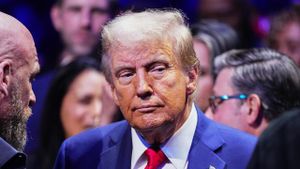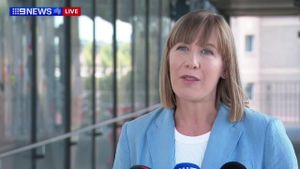Israeli Prime Minister Benjamin Netanyahu arrived in Washington this week for high-stakes talks with U.S. President Donald Trump, marking the first meeting between the two leaders since Trump's return to the White House. The agenda is packed with pressing issues, particularly the fragile ceasefire with Hamas and the potential for a historic normalization of relations between Israel and Saudi Arabia.
Netanyahu, who departed Israel on Sunday, expressed optimism about the forthcoming discussions, stating, "We have the opportunity to strengthen Israel’s security, expand the circle of peace, and usher in an era of prosperity, security, and peace through strength." His remarks reflect both his confidence and the high expectations surrounding this diplomatic endeavor.
Relations between Israel and Hamas have been tense since the outbreak of conflict following the militants' unprecedented attack on October 7, 2023, which resulted in massive casualties and the abduction of Israeli hostages. Netanyahu's government has faced significant domestic pressure to continue military operations against Hamas, which has weakened yet still poses challenges to Israel's security.
According to Netanyahu, the upcoming meeting will primarily focus on the path to definitive victory over Hamas, the return of all hostages, and countering the Iranian influence throughout the region. He remarked, "I believe we can redraw the map for the Middle East for the benefit of our peoples and the entire world." This ambition signals Netanyahu's desire not only to quash Hamas but also to leverage recent military successes against Iran's proxies, including Hezbollah.
Simultaneously, Trump’s administration is seeking to turn this moment of military might for Israel—exemplified by recent operations against Iranian-backed groups—into significant diplomatic successes. Trump’s goal of establishing peace agreements with multiple Arab nations has gained traction, particularly with Saudi Arabia, which has shown conditional interest in normalizing relations with Israel.
The dynamics of negotiations have shifted following recent military escalations, with experts noting now is a unique opportunity to establish stable accords throughout the region. Former U.S. Middle East envoy, Robert Satloff, outlined the potential prospect for several peace agreements, saying, "With the right political maneuvers and diplomatic pressure, we could see breakthroughs once thought impossible." He emphasized the need for U.S. ingenuity to navigate these discussions, linking the fate of Hamas to regional engagement efforts.
According to reports, Trump has sent his special envoy, Steve Witkoff, to discuss potential normalization deals with Saudi Arabia—a significant strategic pivot—as the Kingdom seeks stability amid changing geopolitical tides. Witkoff’s engagement underlines the urgency with which the Trump administration is approaching the normalization talks, particularly concerning Biden-era proposals.
"We need to demonstrate resolve and clear intentions to our allies and adversaries alike," stated Witkoff, signaling the administration’s commitment to support Israel amid growing tensions. The proposed normalization, which hinges on the Gaza situation, aims to lay the groundwork for broader Arab acceptance of Israel amid efforts to bolster collective regional security against Iranian aggression.
Notably, Netanyahu must balance his discussions with Trump against the backdrop of his political coalition, which includes far-right factions pushing for continued military engagement with Hamas. Reports indicate certain coalition members oppose any concessions toward the Palestinians, complicatively urging for a resumption of hostilities as the ceasefire approaches its conclusion.
On the ground, the steep toll of the conflict looms large. More than 47,000 Palestinians are believed to have died, with countless others displaced. Under the terms of the temporary ceasefire, progress remains tenuous as discussions about the future of hostages and humanitarian aid evolve. Trump’s administration hopes to secure tangible outcomes during this visit, especially concerning the hostage release and the potential revitalization of the Palestinian Authority as part of larger peace frameworks.
Trump has openly indicated his desire for substantive agreements to emerge from this summit. He has declared, "The ceasefire must become a long-term cessation, enabling more than just temporary relief but paving the way for peace deals with neighbor states, including Saudi Arabia." His approach seeks to challenge entrenched positions from both Israel and Palestine, pushing for innovative solutions born out of current conflicts.
Analysts suggest the meeting might yield significant moves toward brokered agreements. Yet, hurdles remain stalwart as both Netanyahu’s internal pressures and regional dynamics could derail peace initiatives. The upcoming meeting is tinged with greater urgency amid sporadic clashes and tension-filled streets of Gaza and greater public opinion support for peace, with 73% of Israelis backing the normalization talks.
Overall, Trump and Netanyahu's meeting symbolically marks more than just diplomatic niceties; it embodies the complexity of fostering security and peace amid significant historical grievances. While both leaders harbor unapologetically contentious histories with one another, their converging strategies for the Middle East promise to redefine regional alliances.
Yet, the potential success of their agenda rests heavily on international diplomacy and the varied reactions from local leaders. Encouragingly, if handled deftly, this could lay the foundation for diplomatic relations between Israel and Saudi Arabia, signaling transformative changes across the Middle East.
Despite the depth of mistrust wrought by their political journeys, the hope remains—can these two leaders collaboratively initiate substantial change where previously, turmoil persisted?



